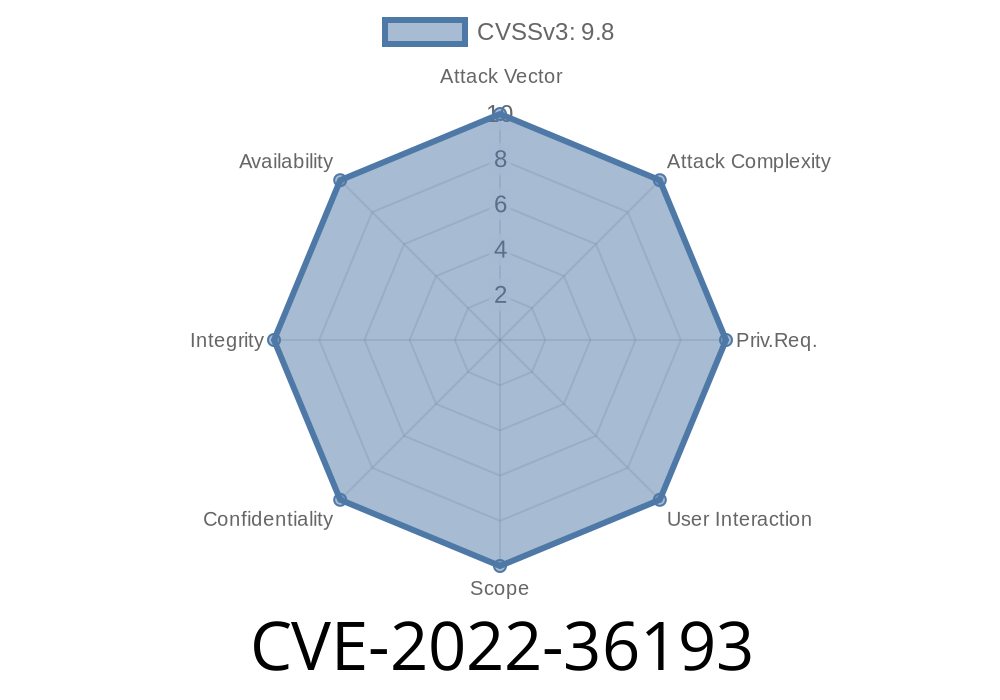In today’s digital world, protecting our sensitive information is more important than ever. Unfortunately, not all software developers take the right measures to make their applications safe. One big example is CVE-2022-36193, a serious vulnerability found in School Management System 1. that lets hackers change or even erase data—without needing to log in.
In this article, we’ll break down what the vulnerability is, how it works, what it means for schools using this system, and provide actual proof-of-concept (PoC) code you can try in a test lab. We keep the details clear and simple so anyone can understand—even if you’re not a security professional.
What is CVE-2022-36193?
CVE-2022-36193 is a security bug called SQL Injection. That means someone from the Internet can send “poisoned” data in a web request, and the software will blindly ask the database to run it—without checking if it’s safe. In other words, the hacker can hijack whatever SQL code the app is supposed to run and force it to run what *they* want instead.
No Login Needed: Attackers can change or destroy info even if they’re not authenticated.
- Persistent Change: This isn’t a read-only risk; bad actors can modify grades, delete users, or corrupt core data.
Where’s the Problem?
The School Management System 1., often used for tracking grades, teachers, classes, or user roles, doesn’t check or “sanitize” input before putting it into a database query. Vulnerable endpoints allow user-supplied values from HTTP requests to be buried, unsanitized, into SQL statements.
A common entry point (based on public reports and source review) is the edit.php or edit_student.php file, which takes values like student_id or class_id directly from URL or form parameters.
Here’s a simple example
// edit_student.php - vulnerable code
$id = $_GET['id']; // user enters ID in the URL
$sql = "SELECT * FROM students WHERE id = $id";
$result = mysqli_query($conn, $sql);
Notice: there are NO quotes or validation checks here! That means anyone could send any value—even code.
Let’s say the server is at
http://school.example.com/edit_student.php?id=1
If an attacker changes the URL to
http://school.example.com/edit_student.php?id=1;DELETE FROM students;
Or, uses classic SQL comment techniques
http://school.example.com/edit_student.php?id=1 OR 1=1
…the database runs both the original query AND any additional code the attacker injects.
`
http://school.example.com/edit_student.php?id=1;DELETE FROM students;--
`
The ; and -- cause the database to execute two commands: first, select from students with id=1, then delete all students. The -- marks the rest of the line as a comment, so no SQL error occurs.
`
http://school.example.com/edit_student.php?id=1 OR 1=1
`
Now, every student record is selected because 1=1 is always true! This can expose private information of every student.
How to Fix It
The best, and easiest, fix is to use *parameterized queries* (also called prepared statements). Never put user input directly in SQL code.
Example Secure Code
// SAFE code using prepared statements
$id = $_GET['id'];
$stmt = $conn->prepare("SELECT * FROM students WHERE id = ?");
$stmt->bind_param("i", $id);
$stmt->execute();
$result = $stmt->get_result();
No matter what value is in $id, the SQL logic stays fixed; the data is passed safely and can’t change the meaning of the query.
More Resources and References
- NVD Entry for CVE-2022-36193
- Exploit-DB Proof of Concept #51121
- OWASP SQL Injection Definition
- Official Project on SourceForge (for code review)
Conclusion: Why This Matters
CVE-2022-36193 is a textbook example of why input validation is *not optional*. Anyone running School Management System 1. without this fix risks losing all their data, or seeing it manipulated by anyone who finds their web address.
Regularly test your web applications for these classic flaws
You can be the difference between a safe school system and one that’s open to attack!
Stay safe. And remember: If you let users type it, you must check it!
Timeline
Published on: 11/28/2022 13:15:00 UTC
Last modified on: 11/28/2022 19:15:00 UTC
